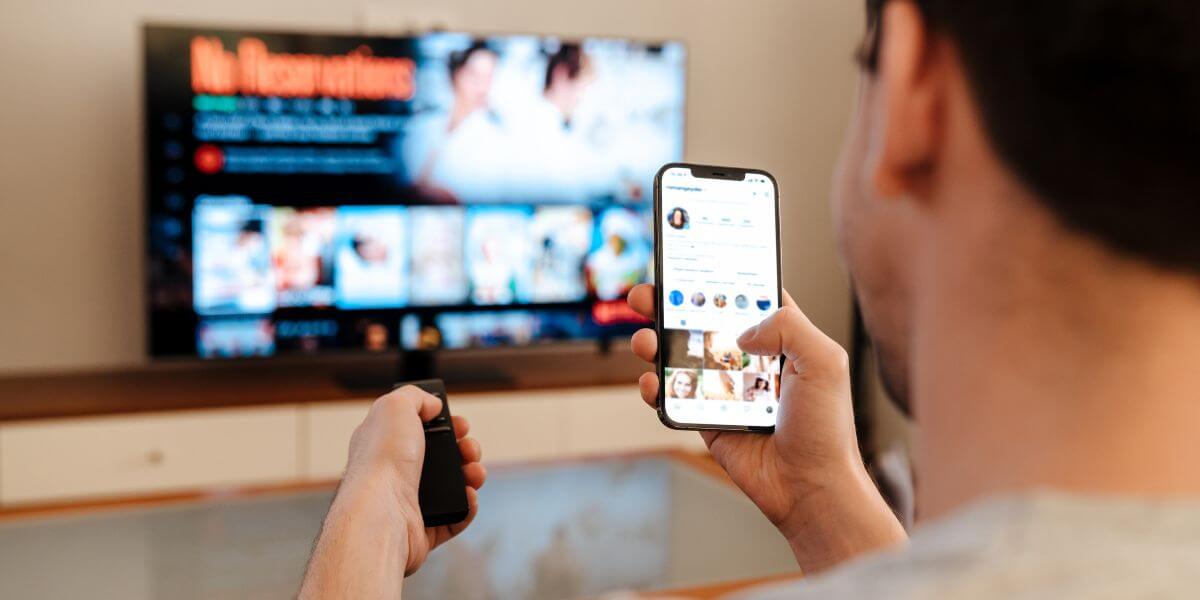Lower your internet bill
61% of people overpay for their internet.
Are you one of them?
Unlock exclusive offers in your area!
Call now
[tel]Enter zip code
1 Star is Poor & 5 Stars is Excellent.
* Required
Written by Sam Watanuki - Pub. Oct 21, 2025 / Updated Oct 21, 2025
Table of Contents
Are you happy with your Internet service?
About the author
Streaming has changed how we consume entertainment, with Americans now spending an average of 32 hours per week watching streaming content according to Nielsen data [1]. But nothing ruins movie night faster than endless buffering or pixelated video quality.
The good news is that finding the best internet for streaming has become easier as providers have upgraded their networks to handle the bandwidth demands of 4K streaming, simultaneous device usage, and cloud gaming.
61% of people overpay for their internet.
Are you one of them?
Unlock exclusive offers in your area!
Call now
[tel]Enter zip code
Streaming has evolved dramatically since the early days of Netflix’s streaming service in 2007 [2]. Back then, a 3 Mbps connection was considered adequate. Today’s Ultra HD and 4K content requires significantly more bandwidth, and with multiple household members streaming simultaneously, your internet connection needs have multiplied. Major internet providers have responded by expanding fiber internet networks, increasing cable speeds, and improving reliability, but not all connections are created equal for streaming purposes.
When evaluating the best internet providers for streaming, two factors matter most: consistent bandwidth and reliable connections. Unlike gaming, which requires ultra-low latency, or video conferencing, which demands symmetrical upload speeds, streaming primarily depends on steady download speeds and network reliability.
Bandwidth is the amount of data your connection can handle at once. Think of it as a highway — more lanes mean more traffic can flow simultaneously without congestion. When multiple people in your household stream different shows, each stream consumes a portion of your total bandwidth. A 100 Mbps connection might seem fast, but if four family members are streaming in 4K simultaneously (each requiring 25 Mbps), you’ll max out your bandwidth and likely experience buffering.
Reliability matters just as much as raw speed. A fiber connection maintains consistent speeds because it uses light signals through glass cables with no electrical interference. Cable internet, while widely available and generally fast, can slow during peak evening hours when neighborhood usage spikes. DSL and satellite connections typically offer the least reliable streaming experiences due to distance limitations and weather interference respectively.

How Much Speed Do You Need for Streaming?
The Federal Communications Commission updated its broadband speed recommendations in 2024 [3], but streaming services each have their own requirements. Netflix recommends 15 Mbps for 4K Ultra HD streaming [4], while Disney+ suggests 25 Mbps for their highest quality content [5]. However, these recommendations apply to a single device.
For practical household use, calculate your needs by multiplying the number of simultaneous streams by the quality level you want. A household with three people streaming in HD (5 Mbps each) needs at least 15 Mbps just for streaming, plus additional bandwidth for web browsing, smart home devices, and downloads happening in the background. Consider adding 50-100 Mbps as a buffer, meaning a family of three to four people should target at least 100-200 Mbps plans for comfortable streaming.
The streaming quality tiers break down as follows:
Newer technologies like 8K streaming (still rare as of 2025) can require 50 Mbps or more per stream, though few services offer this resolution yet.

Which Connection Type Is Best for Streaming?
Fiber-to-the-home is the gold standard for internet for streaming. Providers like Google Fiber, Verizon Fios, and AT&T Fiber deliver symmetrical speeds up to 8,000 Mbps in some markets, with extremely low latency and near-perfect reliability. The direct fiber connection to your home eliminates the bottlenecks that affect other connection types. If fiber is available in your area, it’s almost always your best choice regardless of whether you choose the fastest tier. Even entry-level fiber plans offer excellent streaming performance.
Cable internet serves as a strong second choice and reaches far more households than fiber. Modern cable networks use hybrid fiber-coaxial (HFC) technology, running fiber to neighborhood nodes before switching to traditional coaxial cables for the last stretch to homes. Providers like Xfinity and Spectrum offer speeds up to 2,000 Mbps in many areas. The main drawbacks are potential slowdowns during peak usage times and slower upload speeds compared to fiber. However, for streaming purposes, cable internet performs excellently for most households.
5G home internet has emerged as a viable alternative since major carriers expanded their networks in 2023-2024. T-Mobile and Verizon offer fixed wireless internet with speeds ranging from 50-300 Mbps in covered areas. Performance depends heavily on signal strength and network congestion, but in areas with strong 5G coverage, it provides reliable streaming capability without the need for cable or fiber installation. DSL and satellite internet lag behind for streaming.
DSL speeds decrease dramatically with distance from telephone switching stations, making it pretty unsuitable for 4K streaming in most cases. Satellite internet, while improving with services like Starlink, still faces latency issues and weather-related interruptions that can disrupt streaming sessions.
Google Fiber leads our rankings for the best internet providers for streaming due to its exceptional reliability and multi-gig speeds starting at just $70 monthly [6]. The service offers plans up to 8,000 Mbps with symmetrical upload and download speeds. The major limitation is availability. Google Fiber operates in only 18 metropolitan areas including Atlanta, Austin, Kansas City, and Salt Lake City. If you can get it, Google Fiber eliminates virtually all streaming concerns.
Verizon Fios is great within the Northeast corridor from Virginia to New York. Plans range from 300 Mbps to 2,300 Mbps, all with symmetrical speeds perfect for streaming and other bandwidth-intensive activities [7]. Verizon Fios consistently ranks highest in customer satisfaction surveys and reliability metrics. The service includes no data caps and no equipment fees for customers who use their own router.
Xfinity provides the widest availability among high-performance options, serving 40 states with cable internet up to 2,000 Mbps [8]. While not quite as reliable as fiber options, Xfinity’s extensive network makes it the best choice for many households that can’t access fiber. Watch for promotional pricing that increases after 12 months, and be aware of the 1.2 TB monthly data cap in most markets (though this accommodates roughly 600 hours of HD streaming).
AT&T Fiber covers major metropolitan areas across the South, Midwest, and California with speeds up to 5,000 Mbps [9]. AT&T distinguishes itself with straightforward pricing that doesn’t increase after promotional periods and no data caps on fiber plans. The company has aggressively expanded its fiber footprint, adding millions of locations since 2023.
Spectrum offers cable internet in 41 states without data caps or promotional pricing games. Speeds reach 1,000 Mbps in most areas, and the company includes a free modem (though WiFi access requires an additional monthly fee) [10]. Spectrum works well for streaming households that don’t need multi-gig speeds but want reliable performance and simple pricing.
Provider availability varies dramatically by location. City areas typically offer multiple fast internet for streaming options including fiber and cable, while rural locations may have limited choices. Start by entering your address on provider websites or using a comparison tool to see what’s actually available at your specific location. Availability can vary from one street to the next even within the same neighborhood.
When you compare internet providers, look beyond the advertised speeds to understand the total cost. Many providers charge separate fees for equipment rental ($10-15 monthly), installation ($50-100 one-time), and early termination ($200-300). Some impose data caps that can add overage charges. Calculate the true monthly cost including all fees to make an accurate internet comparison.
Reading recent customer reviews from your specific area provides valuable insights into real-world performance. National reputation matters less than local network quality — a provider might be excellent in one city but problematic in another due to infrastructure age and maintenance practices. Check reviews from the past six months since internet performance can change with upgrades or increased demand.

Compare Internet Plans Strategically
Internet prices vary based on speed tiers, contract terms, and whether you bundle services. Entry-level plans from major providers typically start around $30-50 monthly for speeds of 100-300 Mbps — adequate for most streaming households. Mid-tier plans ($50-80 monthly) offer 500-1,000 Mbps, providing substantial headroom for multiple 4K streams and other bandwidth uses. Premium multi-gig plans ($100-150+ monthly) make sense primarily for extremely large households or those who also game competitively and download large files frequently.
Contract-free plans offer flexibility but sometimes cost $10-20 more monthly than contract options. However, promotional pricing on contract plans typically expires after 12 months, with prices increasing significantly for year two. Calculate the two-year total cost rather than focusing solely on the first year’s promotional rate when comparing options.
Bundling internet with TV or phone service sometimes reduces the per-service cost, but evaluate whether you actually need the bundled services. Many streaming households have abandoned traditional cable TV, making TV bundles unnecessary. However, some providers offer better internet-only pricing than others, so compare both bundled and standalone internet plans.
For a single 4K stream, you need 15-25 Mbps depending on the streaming service. Netflix requires 15 Mbps for 4K, while some services recommend 25 Mbps. For multiple simultaneous 4K streams, multiply accordingly and add buffer capacity. A household with three 4K streams should have at least 100 Mbps to ensure smooth performance.
Yes, fiber internet provides the most reliable streaming experience with consistent speeds regardless of time of day. While cable internet often works well for streaming, fiber eliminates the slowdowns that can occur during peak evening hours. If fiber is available at a comparable price to cable in your area, it’s worth choosing for the superior reliability.
Data caps can impact heavy streaming households. One hour of 4K streaming consumes approximately 7 GB of data, meaning a 1.2 TB monthly cap allows about 170 hours of 4K streaming. For households streaming several hours daily across multiple devices, this could become limiting. Look for providers offering unlimited data or higher caps if you stream extensively.
Yes, 5G home internet works well for streaming in areas with strong 5G coverage. Most 5G home internet plans offer speeds of 100-300 Mbps, sufficient for multiple HD or 4K streams. However, performance varies based on signal strength and network congestion. If you have strong 5G coverage at your location, it’s a viable alternative to traditional wired internet, particularly if fiber and cable aren’t available.
[2] Oxford Executive Limited. “Case Study: Netflix’s Transition from DVD Rental to Streaming.”
[3] FCC. “FCC INCREASES BROADBAND SPEED BENCHMARK.”
[4] Netflix. “Netflix-recommended internet speeds.”
[5] Disney+. “Internet speed recommendations.”
About the author
Congratulations, you qualify for deals on internet plans.
Speak with our specialists to access all local discounts and limited time offers in your area.
[tel]61% of people overpay for their internet.
Are you one of them?
Unlock exclusive offers in your area!
Call now
[tel]Enter zip code